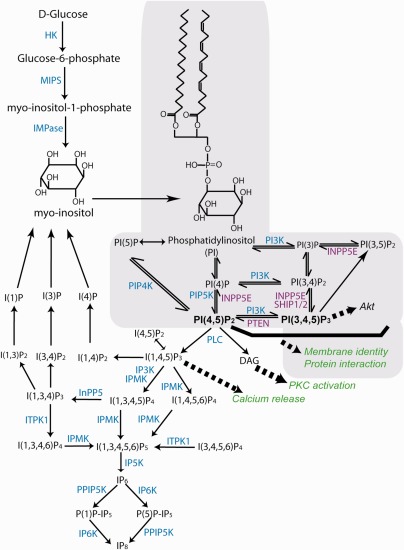Figure 1.

Outline of pathways for synthesis of inositol phosphates and phosphoinositides. Inositol can be obtained from dietary sources or synthesized from D‐glucose by the sequential action of hexokinase (HK), myo‐inositol‐1‐phosphate synthase (MIPS), and inositol monophosphatase (IMPas). The structure of myo‐inositol and phosphatidylinositol are shown (inositol lipids are shaded gray). These molecules form the backbone for synthesis of inositol phosphate (IP) and phosphoinositide (PI) molecules, mediated by action of multiple kinases and/or phosphatases. Enzymes that are discussed in the text are indicated (kinases in blue text, phosphatases in purple text). Notably, several phosphorylation/dephosphorylation steps can be mediated by several enzymes. For example, a number of kinases exist as multiple isoforms (e.g., PIP5K and PI3K [PI3‐kinase]), while several phosphatases can act to dephosphorylate PI(3,4,5)P3 (e.g., INPP5E, SHIP1, and SHIP2). In addition, some enzymes act at multiple steps (e.g. IPMK acts to phosphorylate inositol at a number of steps). Examples of downstream functional effects of key molecules are indicated in italics (green text). PLC, phospholipase C; DAG, diacylglycerol; PKC, protein kinase C; IPMK, inositol phosphate multikinase; ITPK1, inositol 1,3,4‐triphosphate 5/6 kinase.
